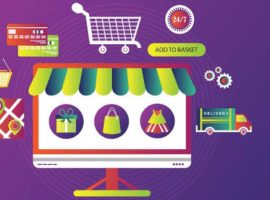7 essential elements to win in the omnichannel commerce future
 Retail today is all about omnichannel commerce and seamless shopping experiences. Discover 7 essential elements to win the omnichannel future.
Retail today is all about omnichannel commerce and seamless shopping experiences. Discover 7 essential elements to win the omnichannel future.
The retail and e-commerce industry is full of acronyms and code words that to an outsider might consider another language – everything from ERP and OMS to wholesale and omnichannel can be confusing – especially since many of the terms overlap, are misused, and simply mean different things to different organizations.
Omnichannel and multichannel e-commerce strategies are two of those terms.
 Retail today is all about omnichannel commerce and seamless shopping experiences. Discover 7 essential elements to win the omnichannel future.
Retail today is all about omnichannel commerce and seamless shopping experiences. Discover 7 essential elements to win the omnichannel future.
The difference between omnichannel and multichannel is that omnichannel includes all possible sales channels in e-commerce. For many organizations, omnichannel means you’re selling everywhere possible, online and offline.
Multichannel selling is considered the selling of goods through multiple – though not all possible – sales channels.
Consider for a moment all of the possible sales channels available to e-commerce brands:
And those are just possibilities right now. New platforms and new ways to sell are popping up every single day.
Omnichannel and multichannel are the terms used to describe the ways retailers tackle multiple channels, whether from an all-inclusive point of view (omnichannel) or a more niche and nuanced strategy (multichannel).
Omnichannel vs. multichannel 2024: What’s the difference and who is doing it?
 Most retailers are now multichannel, where they sell their products across more than one channel. Very few, however, are truly omnichannel. Discover what it means to be considered an omnichannel business.
Most retailers are now multichannel, where they sell their products across more than one channel. Very few, however, are truly omnichannel. Discover what it means to be considered an omnichannel business.
Most of what experts refer to as an omnichannel strategy is also relevant to a multichannel strategy. This is because the goal is to create brand-unique experiences across all sales channels you’re in, but experiences optimized specifically for that channel.
For instance, brands that sell on Amazon as well as their own website often have different products and SKUs they sell through Amazon versus their own site. This is an attempt to better own and understand the customer journey, and build brand loyalty even after a purchase from a marketplace.
Why does this matter? Because when a new customer purchases through Amazon, Amazon brands the entire experience. What you lose by selling on Amazon is a branded customer experience that builds loyalty.
So, how can you get that customer to come back? Well, you can sell different items for the various consumer mindsets. Those who purchase your product on Amazon have a different shopping mentality and relationship with your brand than if they’re buying your item on your own website, or through your Instagram account.
The answering of those questions for each of your channels, whether you’re going for an omnichannel strategy and approach or a multichannel strategy, is how you build out your plan of attack.
Three of the best retailers out there with the best omnichannel examples are:
These brands have figured out how to infiltrate nearly every aspect of their customer’s lives with branded touch points across a variety of channels.
Starbucks doesn’t just have omnichannel strategy, they have an omnichannel funnel that drives in net new customers and increases loyalty over time. This is why they’re considered one of the best at omnichannel strategy in retail.
“We have to think of it (digitally registered customers) as the top of the funnel; an enabler of the relationships that we can create that lead people eventually into the Starbucks Rewards Program.” – Matthew Ryan, Executive Vice President & Global Chief Strategy Officer, Starbucks
The way their funnel works is something like this:
Disney is a fantastic example of omnichannel strategy, yes. They are also an amazing example of perfect linear commerce execution.
The company began by producing content and building a community.
With their personalized suggestions and brick and mortar stores updated to optimize the customer experience, Nike is an outstanding omnichannel example.
Their dedication to revamping their CX is paying off – recognizing digital revenue growth of 35%.
 The future of grocery shopping is omnichannel. To keep order volume up and customers happy, grocers need to keep up with six growing consumer trends.
The future of grocery shopping is omnichannel. To keep order volume up and customers happy, grocers need to keep up with six growing consumer trends.
Mastering an omnichannel strategy isn’t easy. But you can begin with mastering multiple channels and figuring out how to create a funnel that drives in net new customers, surprises and delights them, and makes them repeat customers whether through existing channels – or a completely new one (like Disney+).
Good omnichannel examples and multichannel strategies understand their audience wants and needs, as well as keep a finger on the pulse of innovation and changes in consumer behavior.